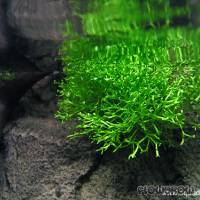



Riccia fluitans aka crystalwort is a floating plant found in all the world. It was scientifically described and catalogised as early as 1753 by Linnaeus, however, Takashi Amano from Japan was the first to keep it submersed in his nature aquaria, using it as an epiphyte by tying it to wood and rocks with a thin fishing line. Thus, Riccia became one of the most favourite plants of plant aquaristis. Meanwhile it has found its way into most plant dealers' product catalogues. There are four different varieties (originating from Japan, Europe, Thailand and Singapore), however, only the variety from Japan is suitable for submersed cultivation.
Riccia fluitans is easy to cultivate. Its wide distribution may be attributed to the fact that it tolerates a multitude of different environmental conditions, e.g. water hardness levels of very soft to really hard, pH values between 5 and 8 and temperatures of 15 to 30 °C. As a floating plant it doesn't require high light intensities, and there is no need to fertilise with CO2. However, when cultivated submersed, tied to rocks and wood, the crystalwort's hunger for light increases considerably, and it also needs more CO2. The plant likes a high nutrient supply, nitrate, phosphate, iron and potassium are a must.
When kept as a floater, your Riccia plant may soon develop into an unsightly cluster. It is easy to trim, though, just remove the parts you want gone. Many times, Riccia is brought into a tank fixed to objects like wood or rocks, however. A hairnet is a good means to do so. Riccia is laid on and then covered with the thin net. By weighing down the net with small rocks you can create a Riccia carpet in the foreground of your aquarium. Overgrown parts may be removed with a pair of scissors, thus you can prevent the lower parts of the plant from dying off due to lack of light, too.
Takashi Amano has shown us the great potential of submersed cultivation of this plant when it comes to setting up a nature aquarium. He was the first to create carpets of Riccia in the fore- and the middleground of an aquarium. Used in this way, Riccia creates a warm atmosphere in the aquarium. However, it may also be used as a floating plant, of course, providing newly hatched fish larvae with cover and e.g. gouramis with support for their bubble nests.
<a href="https://www.flowgrow.de/db/aquaticplants/riccia-fluitans" target="_blank"><img alt="Riccia fluitans" title="Riccia fluitans" src="https://www.flowgrow.de/db/widget/aquaticplants/riccia-fluitans" /></a>
[url=https://www.flowgrow.de/db/aquaticplants/riccia-fluitans][img]https://www.flowgrow.de/db/widget/aquaticplants/riccia-fluitans[/img][/url]
[widget=aquaticplants/riccia-fluitans]Riccia fluitans[/widget]